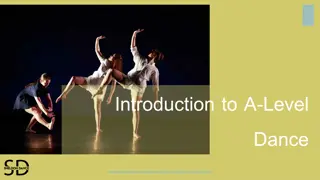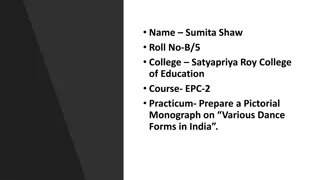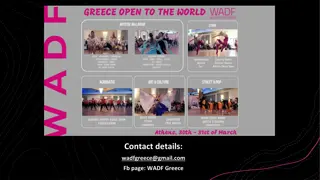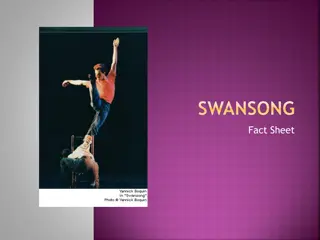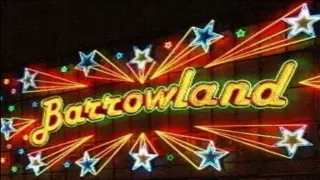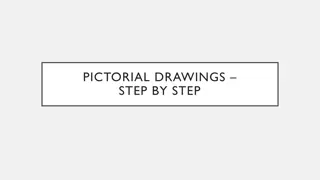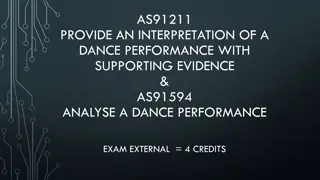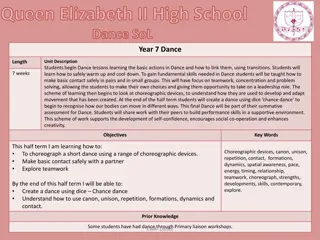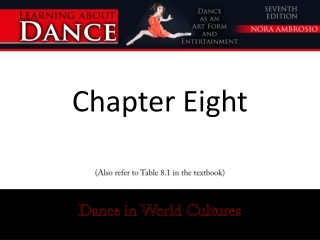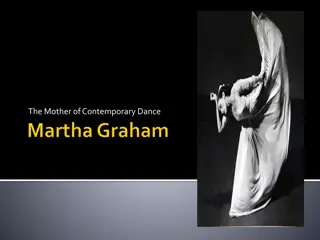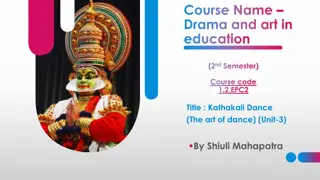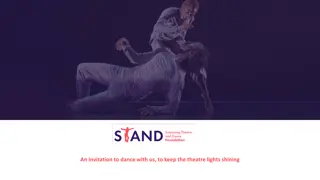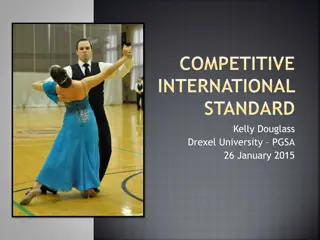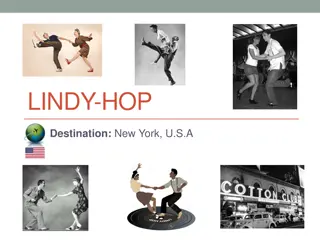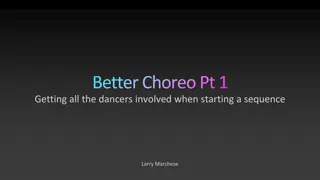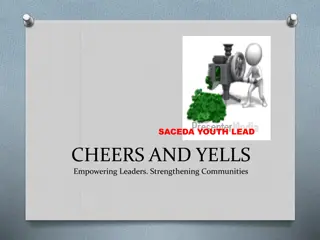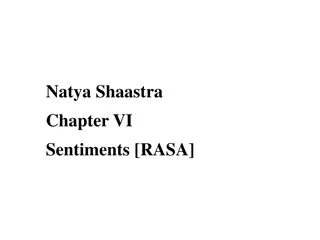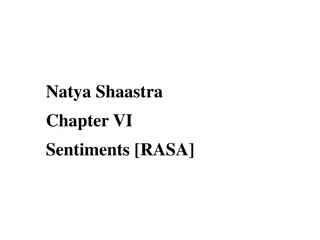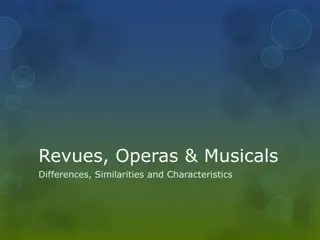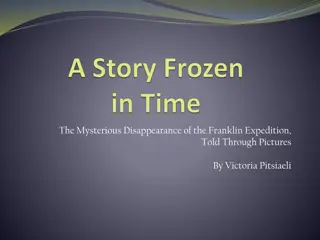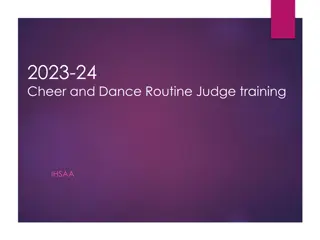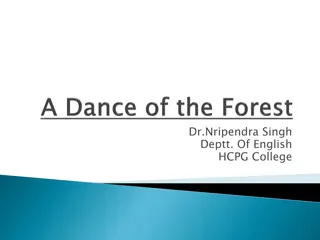Various Dance Forms in India: A Pictorial Journey
India boasts a rich cultural tapestry of dance forms, encompassing classical and folk traditions. This monograph delves into the history, costumes, and makeup of two prominent classical forms: Bharatanatyam and Kathak. Explore the origins, costumes, and unique makeup techniques that define these intricate dance styles, showcasing the vibrancy and diversity of Indian dance heritage.
Download Presentation

Please find below an Image/Link to download the presentation.
The content on the website is provided AS IS for your information and personal use only. It may not be sold, licensed, or shared on other websites without obtaining consent from the author. Download presentation by click this link. If you encounter any issues during the download, it is possible that the publisher has removed the file from their server.
E N D
Presentation Transcript
Satyapriya Satyapriya Roy College of Education College of Education Roy Course-EPC-2 (1.2EPC2) DRAMA AND ARTS IN EDUCATION Prepare a pictorial monograph on "Various Dance forms in India NAME: AHANA BANERJEE COLLEGE ROLL NO.: B/22 REGISTRATION NO.: 2011002002 of 2020-21 CLASS: B.ED, SEMESTER II SESSION: 2020-2022
INTRODUCTION India has many dances, coming from every state in the country, although there are only six forms of the classical dances recognised by India on a national level. They are Bharatnatyam, Kathak, Kathakali, Manipuri, Kuchipudi, and Odissi. The folk dances of India are much more than mere body movements, from the very ancient times the classical dance forms of India is considered as a discipline and a way to devote yourself to God through art. The main 7 types of classical dances of India are discussed here which are: Bharatanatyam Kathak Kathakali Manipuri Odissi Mohininatyam Kuchupudi
BHARATANATYAM HISTORY Performed on the celestial tunes of the Carnatic music, Bharatanatyam comes from the state of Tamil Nadu in South. The origins of Bharatanatyam can be traced back to 1000 BC, and it originates from the ancient temples of Tamil Nadu performed by the women of the classical period. COSTUMES: Generally, the costumes of Bharatanatyam have two types. They are Pyjama style and another skirt style. The costumes of Bharatanatyam are prepared by stitching embroidery with different religious motifs and designs.Bharatanatyam costumes for women resemble Indian traditional sari. But the sari is not a single piece; it is the combination of many varieties of cloth piece. The color of the costumes is very bright and attractive.
The traditional Bharatanatyam costume for men is very simple. The dress covers the lower body of the dancer and upper part cover with a simple jewel, do not use the garments for the upper part of the male dancer. The dhoti stitched with rich embroidery and silk threads use to stitch to farm the designs on dhoti. MAKEUP: Makeup to a Bharatanatyam dancer is very unique, should display the theme of the dance on face movements. Heavy lines are drawn around the eyes and darken and extended outwards the eyebrows. The total Bharatanatyam performance is mostly based on the movements of the eyes and eyebrows. So eyebrows decorate to visual the movements clearly, then the spectators easily attach to the dance. A red dye applied to the tips of the toes, fingertips, and soles of the feet. The color also applied in the palm in a solid circle. The red color decoration to legs and hands emphasize the movements of hands and legs.
KATHAK Kathak is one of the main genres of ancient Indian classical dance and is traditionally regarded to have originated from the travelling bards of North India referred as Kathakars or storytellers. HISTORY: The word Kathak is deduced from the Vedic Sanskrit term Katha which means story while the term kathaka that finds place in several Hindu epics and texts means the person who tells a story. According to Natya Shastra written by ancient Indian theatrologist and musicologist Bharata Muni, the first complete version of the text was completed between 200 BCE to 200 CE, but some sources mention the timeframe to be around 500 BCE and 500CE.
COSTUMES AND JWELERY: As Kathak is popular both in Hindu and Muslim communities the costumes of this dance form are made in line with traditions of the respective communities. There are two types of Hindu costumes for female dancers. While the first one includes a sari worn in a unique fashion complimented with a choli or blouse that covers the upper body and a scarf or urhni worn in some places, the other costume includes a long embroidered skirt with a contrasting choli and a transparent urhni. Costume is well complimented with traditional jewellery, usually gold, that includes the ones adorning her hair, nose, ear, neck and hand. Musical anklets called ghunghru made of leather straps with small metallic bells attached to it are wrapped in her ankles that produce rhythmic sound while she performs excellent and spectacular footwork. Hindu male Kathak dancers usually wear a silk dhoti with a silk scarf tied on the upper part of the body which usually remain bare or may be covered by a loose jacket. Jewellery of male dancers is quite simple compared to their female counterparts and are usually made of stone. The costume for Muslim female dancers includes a skirt along with a tight fitting trouser called churidar or pyjama and a long coat to cover the upper body and hands. A scarf covering the head compliments the whole attire which is completed with light jewellery. MAKEUP: Vivid face make-up put on helps highlight the facial expressions.
KATHAKLI Kathakali , an important genre in the Indian classical dance form, is associated with storytelling form of this art. It is the dance drama from the south Indian state of Kerala. HISTORY Elements and aspects of Kathakal are taken from ancient Sanskrit texts such as the Natya Shastra. The kathakali is attributed to sage Bharata and its first complete compilation is dated to between 200 BCE and 200 CE,but estimates vary between 500 BCE and 500 CE.
MAKEUP The costume is elaborate andthe faceis painted in vivid hues. The Vesham or makeup is of five types - Pacha, Kathi, Thadi, Kari and Minukku. The pomp and magnificence of Kathakali is partly due to its d cor, part of which is the kireetam (huge ornamental headgear) and the kanchukam (over sized jackets), and a long skirt worn over a thick padding of cushions. The artists completely immerse themselves and the audience into the story they're describing. Pacha (Green) Pacha Vesham or the green make-up portrays noble protagonists. Kathi (Knife) Kathi Vesham portrays villainous characters. Thadi (Beard) There are three types of beards or Thadi Veshams. VellaThadi or White beard for superhuman monkeys like Hanuman. ChuvannaThadi or Red beard meant for evil characters. KaruthaThadi or Black beard for the hunter. Kari (Black) Kari Vesham is used for she-demons Minukku (Prettying Up) The "Minukku Vesham" is used for female characters and sages.
MANIPURI Manipuri dance is counted among major classical dance forms of India, especially noted for themes based on Vaishnavism and spectacular execution of Ras Lila , dance dramas based on love between Radha and Krishna. Other themes included in this art form associate with Shaktism, Shaivism and on the sylvan deities called Umang Lai during Manipuri festival Lai Haraoba . This dance form is named after the north-eastern state of Manipur, India from where it originated but it has its roots in Natya Shastra . HISTORY: The first reliably dated written texts describing the art of Manipuri dance are from the early 18th- century.
COSTUMES: The costumes for Manipuri dancers, particularly for women are quite unique from other Indian classical dance forms. A male dancer wears a bright coloured dhoti, also referred as dhora or dhotra that covers lower part of his body from waist. The unique style of wearing it gives the dancer the flexibility to perform his footwork. A crown decorated with peacock feather adorns the dancer s head, who portrays the character of Lord Krishna. The costume of female dancers resembles that of a Manipuri bride, referred as Potloi costumes. The most distinguished of these is the Kumil costume that is an exquisitely embellished long skirt in the shape of a barrel with a stiffened bottom. The skirt is embroidered with fine gold and silver works decorated with small mirror pieces and designs of lotus and other natural items as border prints. The top border of Kumil adorns a wavy and translucent fine skirt tied in three places around the waist in Trikasta and opens up like a flower. A velvet choli or blouse adorns the upper part of the body and a translucent veil white in colour covers the head. The dancer wears round shaped jewellery or garlands of flowers to adorn her face, hand, neck, waist and legs that synchronize well with her costume. A Manipuri dancer does not wear a ghunghroo.
ODISSI Odissi or Orissi is one of the pre-eminent classical dance forms of India which originated in the Hindu temples of the eastern coastal state of Odisha in India. Age-old tradition of Odissi is manifested from Odisha Hindu temples and various sites of archaeological significance that are associated with Hinduism, Jainism and Buddhism, the sculptures of which adorn dance postures of this art form. HISTORY The origins of this dance can be traced back to the 2nd century B.C. carvings of the Rani Gumpa caves in Udaygiri, Odisha. The Natya Shastra refers to this dance as Odar Magadha. It is considered to be one of the oldest dances in the world.
COSTUMES The female dancers wear brightly coloured sari usually made of local silk adorned with traditional and local designs such as the Bomkai Saree and the Sambalpuri Saree. The front part of the sari is worn with pleats or a separate pleated cloth stitched in front to ensure flexibility of movements of the dancer while showcasing excellent footwork. Silver Jewellery adorns her head, ear, neck, arms and wrists. Musical anklets called ghunghru made of leather straps with small metallic bells attached to it are wrapped in her ankles while her waist is tied with an elaborate belt. Her feet and palms are brightened with red coloured dyes called alta. She wears a tikka on forehead and outlines her eyes prominently with Kajal so as to make her eye movements more visible. Her hair is tied in a bun and beautified with Seenthi. A moon shaped crest of white flowers or a Mukoot that is a reed crown with peacock feathers symbolising Lord Krishna may adorn the hairdo. A male dancer wears a dhoti neatly pleated in the front and tucked between the legs that cover his lower body from waist while the upper body remains bare. A belt adorns his waist.
MOHINIYATTAM Mohiniyattam literally interpreted as the dance of Mohini , thecelestial enchantress of the Hindu mythology, is the classical solo dance form of Kerala. History References of Mohiniyattam can be found in the texts Vyavaharamala written in 1709 by Mazhamagalam Narayanan Namputiri and in Ghoshayatra, written later by great poet Kunjan Nambiar. This dance form of Kerala was structured into the present day classical format by the Travancore Kings, Maharaja KartikaTirunal and his successor Maharaja Swati Tirunal (18th -19th century C.E.).
CHARACTERISTICS: Mohiniyattam is characterized by graceful, swaying body movements with no abrupt jerks or sudden leaps. It belongs to the lasya style which is feminine, The movements are emphasized by the glides and the up and down movement on toes. The foot work is not terse and is rendered softly. Mohiniyattam lays emphasis on acting. The dancer identifies herself with the character and sentiments existing in the compositions like the Padams and Pada Varnams which give ample opportunity for facial expressions tender and graceful. COSTUMES: The Mohiniyattam Dance Dress is an off-white plain saree, embellished with a gold-laced or bright golden-colored brocade, embroidered on the borders. A matching blouse finishes the adornment. The front part of the saree has a pleated cloth, having saffron or golden colored bands, starting from the waist. This kind of dress is specially designed so that the wonderful poses by the feet, can be shown to the audiences.
MAKEUP: The Mohiniyattam costume is not complete without the proper makeup needed for the graceful performance. The feet and the fingers of the dancers are smeared with red dyes, having a natural origin. This is meant for highlighting the gestures and mudras of the hands. To put more highlight on the costume of Mohiniyattam Dance,the face makeup is not that heavy. It is light with a tika on the forehead, dark red-coloured lips and eyes, prominently lined with kajal, to showcase the eye movements. The hair is specifically tied, with the alignment towards the left side, known as the chignon hairstyle. Flowers also beautify the bun, with jasmine receiving primary importance.
KUCHIPUDI Kuchipudi, one of six classical dance styles of India. Kuchipudi is indigenous to the state of Andhra Pradesh and differs from the other five classical styles by the inclusion of singing. History: Kuchipudi originated in the 17th century with the creation by Sidhyendra Yogi of the dance- drama Bhama Kalapam, a story of Satyabh ma, the charming but jealous wife of the god Krishna.
COSTUMES & MAKEUP: The traditional Kuchipudi was performed by all males troupe. A dancer in a male role would be in Angivastra, also known as Bagalbandi, wear a dhoti (a single pleated piece of cloth hanging down from the waist).A dancer in a female role would wear a Sari with light makeup. Modern productions retain the male dress, but are more elaborate and Bharatanatyam-like for the female roles. Women artists wear a brilliantly colourful Sari (or a body fitting dress) with a pleated fan stitched in front to help highlight the exacting footwork.The end of the wrapped Sari is held fast under a light metallic (golden or brass) belt at waist. A Kuchipudi artist braids her hair somewhat differently than a Bharatanatyam artist, to reflect the regional traditions, yet wearing flowers are common. Both have symbolic elements embedded in their hair and face jewelry, such as the Vedic symbolisms for the sun and the moon, the soul and the nature, and she sometimes sets her hairdo in the tribhuvana style which represents the three worlds.Her jewelry may include hair jewelry, ear, nose, armlets, necklaces and often a leather anklet piece with little bells (ghungroo).The forehead has a round red bindi or a symmetric tillaka, while the eyes are typically ringed with black collyrium to ease the viewing of expressions by the audience
EDUCATIONAL IMPLICATIONS Dance to communicate Dance to develop skills Dance to create Dance to relieve stress Dance to focus Dance for the future
REFERENCES www.holidify.com www.britannica.com


